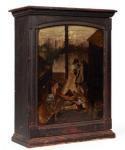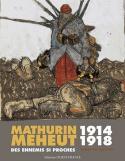Art Of The Day Weekly
#346 - from 15 May 2014 to 21 May 2014
IN THE AIR
Richter, a master for the 21st century
BASEL – If one is born in Dresden, one cannot be indifferent to the fact it was the city most bombed during World War II. That is the case of Gerhard Richter (1932) who naturally was very interested in the history of his time, and in particular in the episode of the Red Armed Fraction (Rote Armee Fraktion), which in the 1970s unveiled all the tensions of German society (his cycle 18 October 1977 from the MoMA). By taking a photograph to create another reality, he demonstrates his intention to “settle matters” with this medium - photography – which mercilessly turned us into witnesses of all the horrors of this century. But he also used it for his research into portraits, landscapes and still lives. The one hundred works presented, some of them very recent, shortly after the large retrospective at the Centre Pompidou, confirm Richter’s central position in contemporary art.
• Gerhard Richter, Tableaux/Séries at the Fondation Beyeler, from 18 May to 7 September 2014.
EXHIBITIONS
Latest news from Iran
PARIS – The political events in Iran have almost completely obliterated Iranian culture in the Western minds. But the country’s cinema now has a good reputation, which at a certain time it shared with photography. We well remember an Iranian season prepared in 2001 by the city of Paris. But visual arts are not present. We are –almost- totally ignorant in that field. The retrospective of the last fifty years shows the production is not limited to the politically correct Islam: artists have explored the paths of painting, as well as conceptual art, installations, and protest billboards. Some two hundred works by some twenty artists, from Bahman Mohassess to Barbad Golshiri, help us visualize a scene one could not have imagined as varied and receptive to the major Western currents.
• Unedited History Iran 1960-2014 at the musée d’Art moderne de la Ville de Paris, from 16 May to 24 August 2014.
De Stäel in the nude
ANTIBES – Nicolas de Staël is among the tortured artists of the XXth century, having lived in Antibes before committing suicide in 1955 by jumping off the cliffs. , In commemoration of the 100th anniversary of his birth this exhibition studies his relation to nudes.
• Staël, la figure à nu, 1951-1955 at the Picasso museum, from 17 May to 7 Septembre 2014.
The Clark years
LONDON – At hardly the age of thirty he was already the brilliant director of the National Gallery, and a symbol of the spirit of resistance during the Blitz. But Kenneth Clark (1903-1983) was also a very smart art critic, a great collector and one of the first persons to popularize culture on television. This exhibition-tribute explores the different aspects of the person.
• Kenneth Clark : Looking for Civilization at the Tate Britain, from 20 May to 10 August 2014.
On the traces of Antonioni
VIENNA – In Blow Up, Antonioni intimately combined cinema and photography, the set image and the animated image. The exhibition explores the mythology created by this movie by bringing together snapshots by Tazio Secchiaroli, the prince of the paparazzi, Terence Donovan or David Bailey.
Blow Up at the Albertina, from 30 April to 24 August 2014.
AUCTIONS

Lot n°188, Criminal organization chart. [New York, circa 1880-1900]. Wood cabinet (75.2 x 58.2 x 26 cm). Estimate: €30,000 - €40,000.
Murders and murderers
PARIS – We all remember Voltaire pulling out the Calas file again, or Zola bringing up the Dreyfus affair: literature loves to periodically straighten up judicial errors or to intervene to soften the situation of the condemned. There is a lot of work in that field, as we can see in this original collection, totally built on the theme of penal justice and punishment. From the guard at the prison of Cayenne who gave the menu in details to his ‘protegés’ to the report in 1572 on the Martin Guerre case, up to the surprising organization chart of New York criminals (the most expensive lot in the sale, estimated at €30 000), we see various eras and latitudes. Such excesses as the “Torture of one hundred pieces” still practiced in China at the beginning of the XXth century, or the hangings in France for futile reasons, seem to belong to another era, as long as our so-called civil society remains just that, civil …
• Collection Philippe Zoumeroff on 16 May 2014 at the hôtel Drouot (SVV Pierre Bergé & Associés).
http://www.pba-auctions.com
ARTISTS OF THE WEEK
Ilya and Emilia Kabakov (re)invent utopia
Ilya Kabakov (born in 1933) became known thanks to his installations on daily life during the Soviet era, among which the communal kitchen at the musée Maillol is a successful example. For the last few decades he has worked with his wife Emilia (born in 1945), and he has been honoured by Monumenta, which every year invites a contemporary artist to take over the 13500 square meters of the Grand Palais. The challenge is not an easy one and the Etrange Cité of the Kabakov couple has trouble filling out all the immense space. Yet it seems to match their career and their questionings: themed rooms, full of installations or totally empty, touching on constructive utopia, the relation to the sacred or philosophical Pantheism. The latter takes shape in the “noosphere”, a layer of the Earth’s atmosphere that would indefinitely preserve all the great ideas of Humanity. Could it only be true…
• Monumenta, Ilya et Emilia Kabakov at the Grand Palais, from 10 May to 22 June 2014.
OPENINGS OF THE WEEK
BOOKS
A painter during the war
On 2 August 1914, a deadly day for the European continent, Breton painter Mathurin Méheut (1882-1958) was enjoying a lovely stay in Japan, through a scholarship from the Albert Kahn foundation. He cannot imagine being a deserter, and heads back to France to join his regiment, at Saint-Lô. He is assigned to the map service, and spent four years as close as possible to the massacre, on some of the most deadly battle fields of that war, from Artois to Argonne, from the Somme region to Flanders. On 8 December 1914, he received a true Christmas present, a box of watercolours: it helped him sketch the unspeakable, the bodies, the towns in ruins such as Arras, the trenches and the trials at using gas masks, the barracks under the snow and the downed planes. But he also reproduces the flowers which ignore the bombs, the dragonflies and the flies, the animals fleeing the abandoned farms … Méheut’s work has been compared to that of Otto Dix, though it is less unbearable but it is close to the descriptions by Ernst Jünger and Maurice Genevoix, other witnesses of the great tragedy we commemorate this year of its one hundredth anniversary.
• Mathurin Méheut, 1914-1918, by Patrick and Elisabeth Jude, Ouest France, 144 p., €25.


